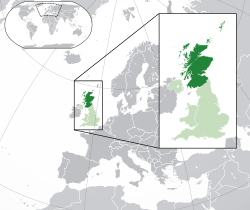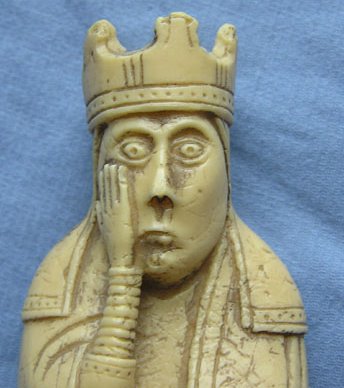| Main Page | Selected articles 1 | Selected articles 2 | Selected biographies | Selected quotes | Selected pictures | Featured Content | Categories & Topics |
Introduction
 |

|
|

| ||
Scotland is a country that is part of the United Kingdom. It contains nearly one-third of the United Kingdom's land area, consisting of the northern part of the island of Great Britain and more than 790 adjacent islands, principally in the archipelagos of the Hebrides and the Northern Isles. In 2022, the country's population was about 5.4 million. Its capital city is Edinburgh, whilst Glasgow is the largest city and the most populous of the cities of Scotland. To the south-east, Scotland has its only land border, which is 96 miles (154 km) long and shared with England; the country is surrounded by the Atlantic Ocean to the north and west, the North Sea to the north-east and east, and the Irish Sea to the south. The legislature, the Scottish Parliament, elects 129 MSPs to represent 73 constituencies across the country. The Scottish Government is the executive arm of the devolved government, headed by the first minister who chairs the cabinet and responsible for government policy and international engagement.
The Kingdom of Scotland emerged as an independent sovereign state in the 9th century. In 1603, James VI succeeded to the thrones of England and Ireland, forming a personal union of the three kingdoms. On 1 May 1707, Scotland and England combined to create the new Kingdom of Great Britain, with the Parliament of Scotland subsumed into the Parliament of Great Britain. In 1999, a Scottish Parliament was re-established, and has devolved authority over many areas of domestic policy. The country has its own distinct legal system, education system and religious history, which have all contributed to the continuation of Scottish culture and national identity. Scottish English and Scots are the most widely spoken languages in the country, existing on a dialect continuum with each other. Scottish Gaelic speakers can be found all over Scotland, but the language is largely spoken natively by communities within the Hebrides; Gaelic speakers now constitute less than 2% of the total population, though state-sponsored revitalisation attempts have led to a growing community of second language speakers.
The mainland of Scotland is broadly divided into three regions: the Highlands, a mountainous region in the north and north-west; the Lowlands, a flatter plain across the centre of the country; and the Southern Uplands, a hilly region along the southern border. The Highlands are the most mountainous region of the British Isles and contain its highest peak, Ben Nevis, at 4,413 feet (1,345 m). The region also contains many lakes, called lochs; the term is also applied to the many saltwater inlets along the country's deeply indented western coastline. The geography of the many islands is varied. Some, such as Mull and Skye, are noted for their mountainous terrain, while the likes of Tiree and Coll are much flatter.
Selected article
Tantallon Castle is a ruined mid-14th-century fortress, located 5 kilometres (3.1 mi) east of North Berwick, in East Lothian, Scotland. It sits atop a promontory opposite the Bass Rock, looking out onto the Firth of Forth. The last medieval curtain wall castle to be constructed in Scotland, Tantallon comprises a single wall blocking off the headland, with the other three sides naturally protected by sea cliffs.
Tantallon was built in the mid 14th century by William Douglas, 1st Earl of Douglas. It was passed to his illegitimate son, George Douglas, later created Earl of Angus, and despite several sieges, it remained the property of his descendants for much of its history. It was besieged by King James IV in 1491, and again by his successor James V in 1527, when extensive damage was done. Tantallon saw action in the First Bishops' War in 1639, and again during Oliver Cromwell's invasion of Scotland in 1651, when it was once more severely damaged. It was sold by the Marquis of Douglas in 1699 to Hew Dalrymple, Lord North Berwick and the ruin is today in the care of Historic Environment Scotland. (... Read the full article)
Selected quotes
In the news
Selected biography
Sir Kenneth Mathieson Dalglish (born 4 March 1951) is a Scottish former football player and manager. He is regarded as one of the greatest players of all time as well as one of Celtic's, Liverpool's and Scotland's greatest ever players. During his career, he made 338 appearances for Celtic and 515 for Liverpool, playing as a forward, and earned a record 102 caps for the Scotland national team, scoring 30 goals, also a joint record. Dalglish won the Ballon d'Or Silver Award in 1983, the PFA Players' Player of the Year in 1983, and the FWA Footballer of the Year in 1979 and 1983. In 2009, FourFourTwo magazine named Dalglish the greatest striker in post-war British football, and he has been inducted into both the Scottish and English Football Halls of Fame. He is highly regarded by Liverpool fans, who still affectionately refer to him as "King Kenny", and in 2006 voted him top of the fans' poll "100 Players Who Shook the Kop".
Dalglish began his career with Celtic in 1971, going on to win four Scottish league championships, four Scottish Cups and one Scottish League Cup with the club. In 1977, Liverpool manager Bob Paisley paid a British transfer record of £440,000 to take Dalglish to Liverpool. His years at Liverpool were among the club's most successful periods, as he won six English league championships, the FA Cup, four League Cups, five FA Charity Shields, three European Cups and one European Super Cup. In international football, Dalglish made 102 appearances and scored 30 goals for Scotland between 1971 and 1986, becoming their most capped player and joint-leading goal scorer (with Denis Law). He was chosen for Scotland's FIFA World Cup squads in 1974, 1978, 1982 and 1986, playing in all of those tournaments except the latter, due to injury.
Dalglish became player-manager of Liverpool in 1985 after the resignation of Joe Fagan, winning a further three First Divisions, two FA Cups and four FA Charity Shields, before resigning in 1991. Eight months later, Dalglish made a return to football management with Blackburn Rovers, whom he led from the Second Division to win the Premier League in 1995. Soon afterwards, he stepped down as manager to become director of football at the club, before leaving altogether in 1996. In January 1997, Dalglish took over as manager at Newcastle United. Newcastle finished as runners-up in the Premier League during his first season, but they only finished 13th in 1997–98, which led to his dismissal the following season. Dalglish went on to be appointed director of football at Celtic in 1999, and later briefly manager. He won the Scottish League Cup in 2000 before his departure from the club that year.
Between 2000 and 2010, Dalglish focused on charitable concerns, founding The Marina Dalglish Appeal with his wife to raise money for cancer care. In January 2011, Dalglish returned to Liverpool for a spell as caretaker manager after the dismissal of Roy Hodgson, becoming the permanent manager in May 2011. Despite winning the League Cup, which was the club's first trophy since 2006, earning them a place in the UEFA Europa League, and reaching the FA Cup Final, Liverpool only finished 8th in the Premier League, and Dalglish was dismissed in May 2012. In October 2013, Dalglish returned to Liverpool as a non-executive director, and Anfield's Centenary Stand was renamed after him in October 2018. (... Read the full article)
Selected picture
Did You Know...

- ... that Carrbridge Packhorse Bridge is the oldest-known stone bridge in the Scottish Highlands?
- ... that Prince Philip was the first member of the British royal family to fly in a helicopter?
- ... that buddleia grows from the exterior of the Church Street School swimming pool in Glasgow?
- ... that the Aesculapian Club, founded in Edinburgh in 1773, still meets twice a year?
- ... that Davy Russell won a 2025 Scottish election despite being dubbed the "invisible man" by an opponent?
- ... that the 4,000-year-old Ravenswood standing stone now lies in a cul-de-sac in a 1970s Scottish housing estate?
- ... that the Scottish painter Carole Gibbons had her first US exhibition in her eighties?
- ... that the Scottish invasion of England in 1648 was defeated by an army less than half their size?
Get involved
For editor resources and to collaborate with other editors on improving Wikipedia's Scotland-related articles, see WikiProject Scotland.
To get involved in helping to improve Wikipedia's Scotland related content, please consider doing some of the following tasks or joining one or more of the associated Wikiprojects:
- Visit the Scottish Wikipedians' notice board and help to write new Scotland-related articles, and expand and improve existing ones.
- Visit Wikipedia:WikiProject Scotland/Assessment, and help out by assessing unrated Scottish articles.
- Add the Project Banner to Scottish articles around Wikipedia.
- Participate in WikiProject Scotland's Peer Review, including responding to PR requests and nominating Scottish articles.
- Help nominate and select new content for the Scotland portal.
Do you have a question about The Scotland Portal that you can't find the answer to?
Post a question on the Talk Page or consider asking it at the Wikipedia reference desk.
Related portals
Other language versions
Associated Wikimedia
The following Wikimedia Foundation sister projects provide more on this subject:
-
Commons
Free media repository -
Wikibooks
Free textbooks and manuals -
Wikidata
Free knowledge base -
Wikinews
Free-content news -
Wikiquote
Collection of quotations -
Wikisource
Free-content library -
Wikispecies
Directory of species -
Wikiversity
Free learning tools -
Wikivoyage
Free travel guide -
Wiktionary
Dictionary and thesaurus
























































